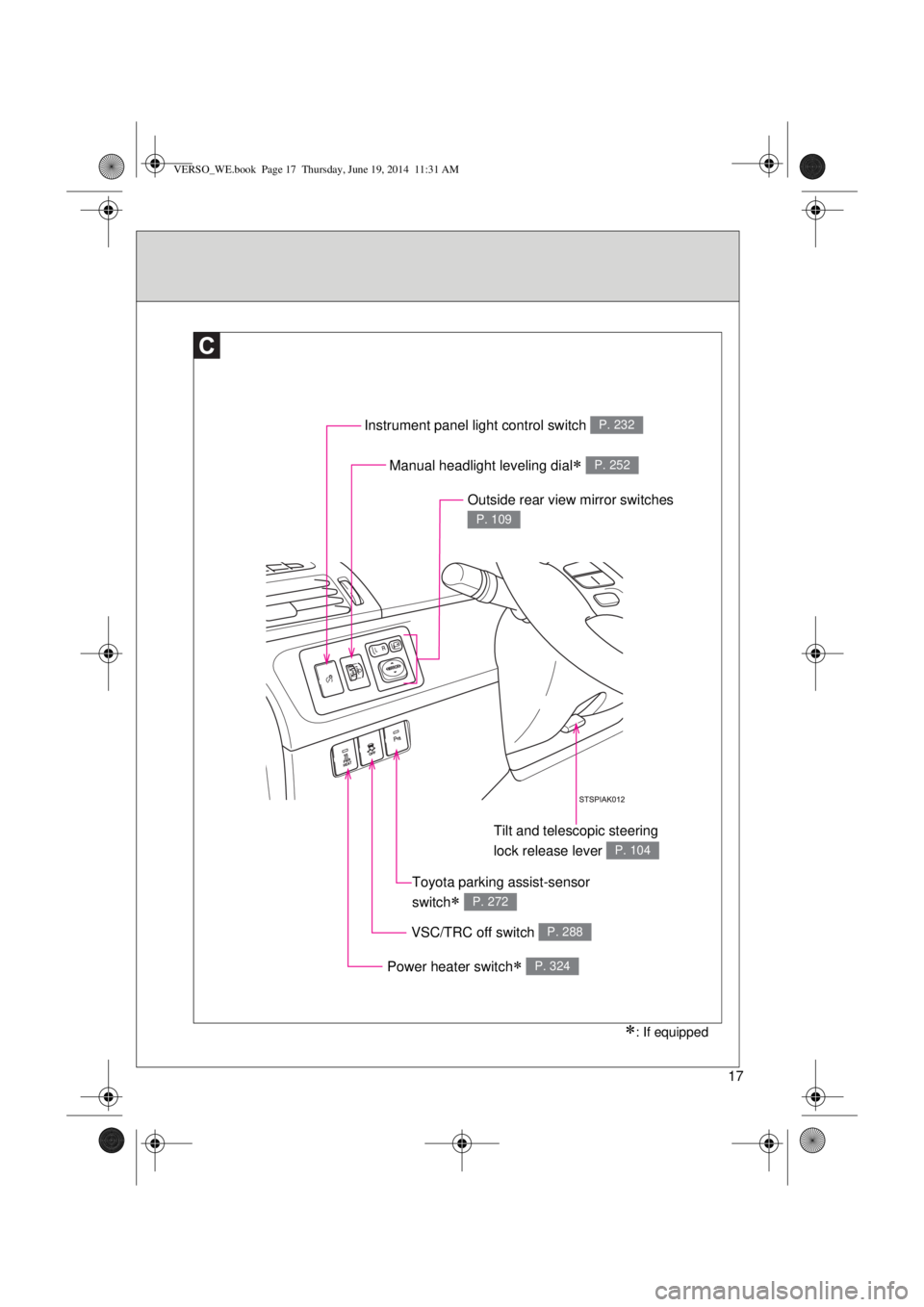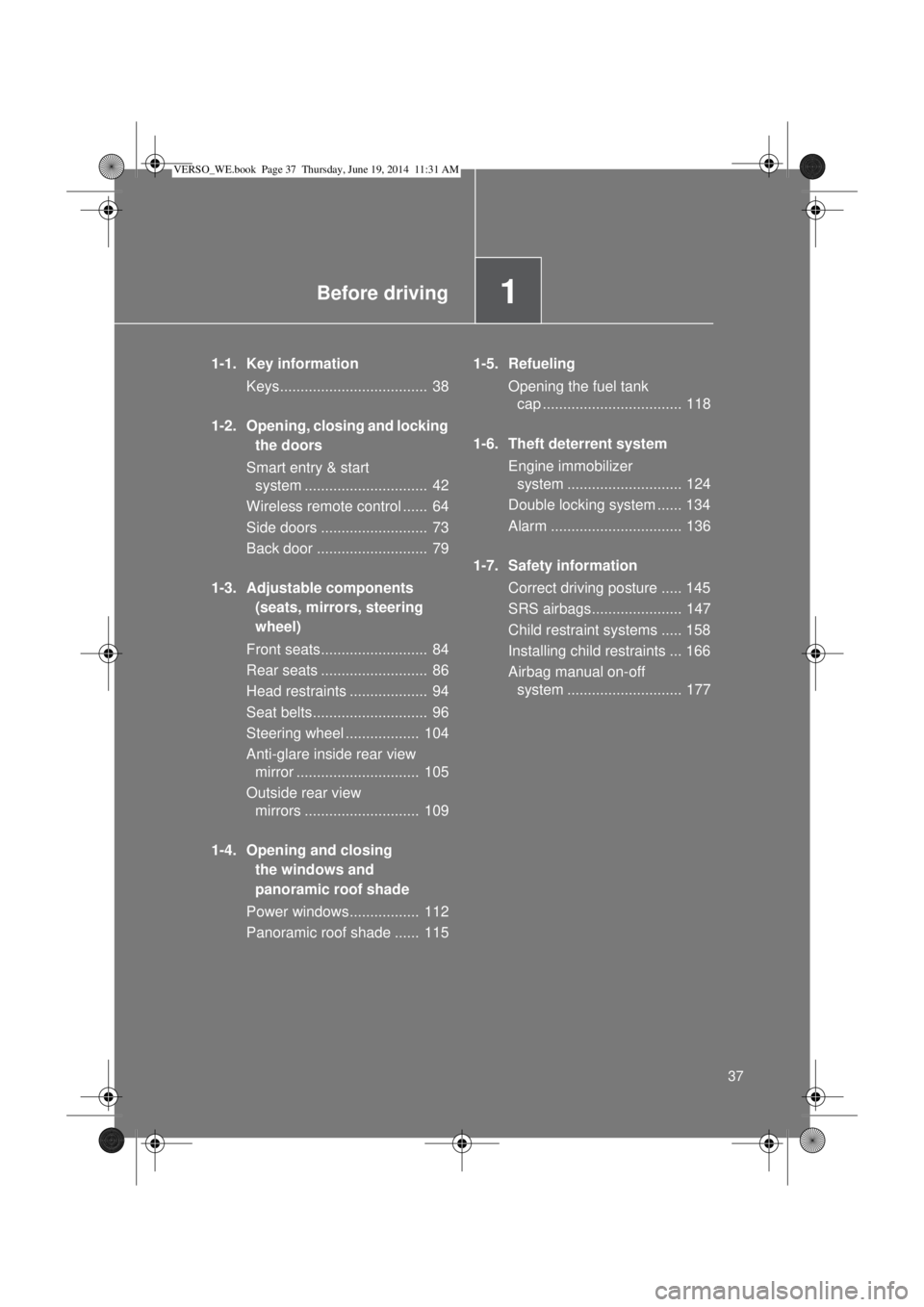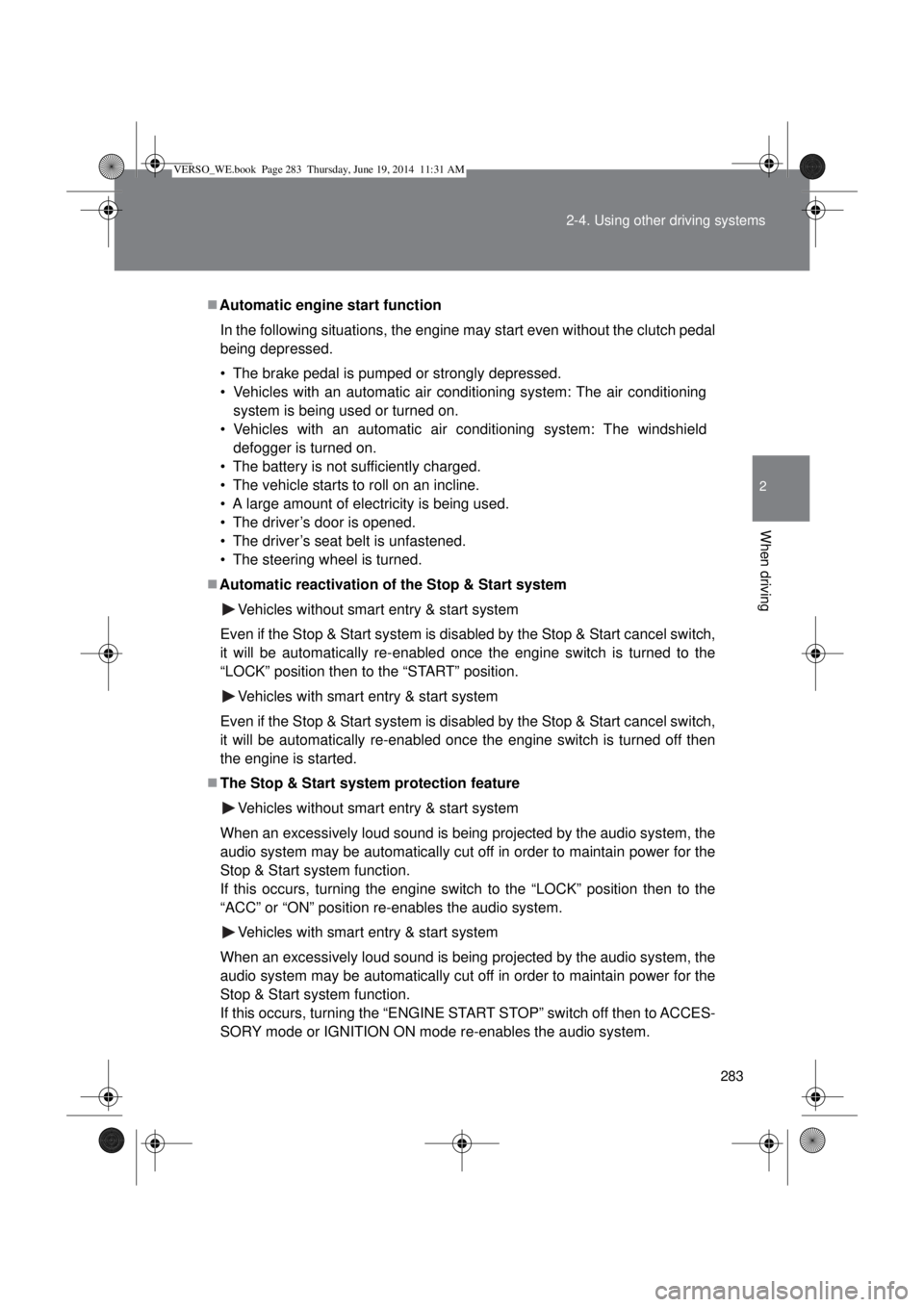power steering TOYOTA VERSO 2014 Owners Manual
[x] Cancel search | Manufacturer: TOYOTA, Model Year: 2014, Model line: VERSO, Model: TOYOTA VERSO 2014Pages: 650, PDF Size: 36.61 MB
Page 2 of 650

TABLE OF CONTENTSIndex
2
1-1. Key information
Keys ...................................... 38
1-2. Opening, closing and locking
the doors
Smart entry & start system.. 42
Wireless remote control ........ 64
Side doors............................. 73
Back door.............................. 79
1-3. Adjustable components
(seats, mirrors, steering
wheel)
Front seats ............................ 84
Rear seats........................... 86
Head restraints ..................... 94
Seat belts .............................. 96
Steering wheel .................... 104
Anti-glare inside rear view mirror
105
Outside rear view mirrors.... 109
1-4. Opening and closing the win-
dows and panoramic roof
shade
Power windows ................... 112
Panoramic roof shade....... 115
1-5. Refueling
Opening the fuel tank cap ... 118
1-6. Theft deterrent systemEngine immobilizer system 124
Double locking system..... 134
Alarm................................ 136
1-7. Safety information
Correct driving posture ....... 145
SRS airbags ....................... 147
Child restraint systems ....... 158
Installing child restraints ..... 166
Airbag manual on-off system ....
177
2-1. Driving procedures
Driving the vehicle .............. 182
Engine (ignition) switch (vehicles
without smart entry & start sys-
tem) .................................. 196
Engine (ignition) switch (vehicles
with smart entry & start system)
200
Multidrive.......................... 206
Automatic transmission.... 212
Manual transmission........ 220
Turn signal lever................. 224
Parking brake ..................... 225
Horn ................................... 227
2-2. Instrument cluster
Gauges and meters............ 228
Indicators and warning lights.....
233
Multi-information display .... 239
1Before driving
2When driving
VERSO_WE.book Page 2 Thursday, June 19, 2014 11:31 AM
Page 3 of 650

1
2
3
4
5
6
3
2-3. Operating the lights and wip-
ers
Headlight switch.................. 251
Fog light switch ................... 258
Windshield wipers and washer ..
259
Rear window wiper and washer .
264
2-4. Using other driving systems
Cruise control.................... 265
Speed limiter..................... 269
Toyota parking assist-sensor...
272
Stop & Start system.......... 280
Driving assist systems ........ 287
Hill-start assist control......... 293
2-5. Driving information
Cargo and luggage ............. 295
Winter driving tips ............... 298
Trailer towing (except Morocco)
302
3-1. Using the air conditioning sys-
tem and defogger
Manual air conditioning system
312
Automatic air conditioning sys-
tem.................................. 317
Power heater..................... 324
Rear window and outside rear
view mirror defoggers ....... 3263-2. Using the audio system
Audio system types.......... 328
Using the radio................. 330
Using the CD player......... 334
Playing back MP3 and WMA
discs............................... 339
Operating an iPod............ 345
Operating a USB memory 352
Optimal use of the audio sys-
tem................................. 359
Using the AUX port........... 361
Using the steering wheel audio
switches ........................... 362
3-3. Using the interior lights
Interior lights list ................. 365
• Personal/interior lights main
switch 366
• Personal/interior lights...... 367
• Personal/interior lights...... 368
3-4. Using the storage features
List of storage features....... 369
• Glove box ......................... 370
• Glove box and console box .....
371
• Console box and overhead
console 372
• Overhead console and cup
holders 373
• Cup holders and bottle holders
374
• Bottle holders and auxiliary
boxes 375
• Auxiliary boxes ................. 376
• Auxiliary boxes ................. 377
3-5. Other interior features
3Interior features
VERSO_WE.book Page 3 Thursday, June 19, 2014 11:31 AM
Page 17 of 650

17
Manual headlight leveling dial P. 252
Power heater switch P. 324
Outside rear view mirror switches
P. 109
VSC/TRC off switch P. 288
Tilt and telescopic steering
lock release lever
P. 104
Toyota parking assist-sensor
switch
P. 272
Instrument panel light control switch P. 232
: If equipped
VERSO_WE.book Page 17 Thursday, June 19, 2014 11:31 AM
Page 37 of 650

1Before driving
37
1-1. Key information
Keys.................................... 38
1-2. Opening, closing and locking
the doors
Smart entry & start
system .............................. 42
Wireless remote control ...... 64
Side doors .......................... 73
Back door ........................... 79
1-3. Adjustable components
(seats, mirrors, steering
wheel)
Front seats.......................... 84
Rear seats .......................... 86
Head restraints ................... 94
Seat belts............................ 96
Steering wheel .................. 104
Anti-glare inside rear view
mirror .............................. 105
Outside rear view
mirrors ............................ 109
1-4. Opening and closing
the windows and
panoramic roof shade
Power windows................. 112
Panoramic roof shade ...... 1151-5. Refueling
Opening the fuel tank
cap .................................. 118
1-6. Theft deterrent system
Engine immobilizer
system ............................ 124
Double locking system ...... 134
Alarm ................................ 136
1-7. Safety information
Correct driving posture ..... 145
SRS airbags...................... 147
Child restraint systems ..... 158
Installing child restraints ... 166
Airbag manual on-off
system ............................ 177
VERSO_WE.book Page 37 Thursday, June 19, 2014 11:31 AM
Page 188 of 650

188 2-1. Driving procedures
CAUTION
When driving the vehicle
On vehicles with a Multidrive or an automatic transmission, do not shift the
shift lever to “P” while the vehicle is moving.
Doing so can damage the transmission and may result in a loss of vehicle
control.
Do not shift the shift lever to “R” while the vehicle is moving forward.
Doing so can damage the transmission and may result in a loss of vehicle
control.
Do not shift the shift lever to “D” (Multidrive or automatic transmission) or
“1” (manual transmission) while the vehicle is moving backward.
Doing so can damage the transmission and may result in a loss of vehicle
control.
Moving the shift lever to “N” while the vehicle is moving will disengage the
engine from the transmission. Engine braking is not available when “N” is
selected.
During normal driving, do not turn off the engine. Turning the engine off
while driving will not cause loss of steering or braking control, but the
power assist to these systems will be lost. This will make it more difficult to
steer and brake, so you should pull over and stop the vehicle as soon as it
is safe to do so.
However, in the event of an emergency, such as if it becomes impossible
to stop the vehicle in the normal way: P. 595
Use engine braking (downshift) to maintain a safe speed when driving
down a steep hill.
Using the brakes continuously may cause the brakes to overheat and lose
effectiveness. (P. 206, 212, 220)
When stopped on an inclined surface, use the brake pedal and parking
brake to prevent the vehicle from rolling backward or forward and causing
an accident.
Do not adjust the position of the steering wheel, the seat, or the inside or
outside rear view mirrors while driving.
Doing so may result in a loss of vehicle control that can cause accidents
that may result in death or serious injury.
VERSO_WE.book Page 188 Thursday, June 19, 2014 11:31 AM
Page 194 of 650

194 2-1. Driving procedures
NOTICE
Avoiding damage to vehicle parts
Do not turn the steering wheel fully in either direction and hold it there for
an extended period of time.
Doing so may damage the power steering motor.
When driving over bumps in the road, drive as slowly as possible to avoid
damaging the wheels, underside of the vehicle, etc.
Diesel engine only: Make sure to idle the engine immediately after high-
speed driving or hill climbing. Stop the engine only after the turbocharger
has cooled down.
Failure to do so may cause damage to the turbocharger.
If you hear a squealing or scraping noise (brake pad wear indicators)
Have the brake pads checked and replaced by any authorized Toyota dealer
or repairer, or another duly qualified and equipped professional, as soon as
possible.
The rotor damage can result if the pads are not replaced when needed.
It is dangerous to drive the vehicle when the wear limits of the brake pads
and/or that of the brake discs are exceeded.
If you get a flat tire while driving
A flat or damaged tire may cause the following situations. Hold the steering
wheel firmly and gradually press the brake pedal to slow down the vehicle.
It may be difficult to control your vehicle.
The vehicle will make abnormal sounds.
The vehicle will behave abnormally.
Information on what to do in case of a flat tire. (P. 536, 552)
VERSO_WE.book Page 194 Thursday, June 19, 2014 11:31 AM
Page 205 of 650

205 2-1. Driving procedures
2
When driving
CAUTION
Caution while driving
If the vehicle is coasting without engine power, for example if the engine
stalls, do not open a door or operate the locks until the vehicle is completely
stopped in a safe condition. Driving with the steering locked may cause an
accident, resulting in death or serious injury.
Stopping the engine in an emergency
If you want to stop the engine in an emergency while driving the vehicle,
press and hold the “ENGINE START STOP” switch for more than 2 seconds,
or press it briefly 3 times or more in succession. (P. 595)
However, do not touch the “ENGINE START STOP” switch while driving
except in an emergency. Turning the engine off while driving will not cause
loss of steering or braking control, but the power assist to these systems will
be lost. This will make it more difficult to steer and brake, so you should pull
over and stop the vehicle as soon as it is safe to do so.
NOTICE
To prevent battery discharge
Do not leave the “ENGINE START STOP” switch in ACCESSORY or IGNI-
TION ON mode for long periods without the engine running.
When starting the engine
Do not race a cold engine.
If the engine becomes difficult to start or stalls frequently, have your vehi-
cle checked by any authorized Toyota dealer or repairer, or another duly
qualified and equipped professional immediately.
“ENGINE START STOP” switch operation
If you feel something catching or sense irregular resistance when operating
the “ENGINE START STOP” switch, then there may be a malfunction. Imme-
diately contact any authorized Toyota dealer or repairer, or another duly
qualified and equipped professional.
VERSO_WE.book Page 205 Thursday, June 19, 2014 11:31 AM
Page 282 of 650

282 2-4. Using other driving systems
Operating conditions
The Stop & Start system is operational when all of the following condi-
tions are met:
• The engine is adequately warmed up.
• The battery is sufficiently charged.
• The driver’s door is closed.
• The driver’s seat belt is fastened.
• The hood is closed.
• The clutch pedal is not being depressed.
• The shift lever is in “N”.
• The steering wheel is not in use.
In the following circumstances the engine may not be stopped by the
Stop & Start system. This is not a malfunction of the Stop & Start system.
• Engine coolant temperature is too low or too high.
• The outside temperature is too low.
• Vehicles with an automatic air conditioning system: The air condition-
ing system is being used when the vehicle interior temperature is
extremely high such as after the vehicle was parked under the hot sun.
• Vehicles with an automatic air conditioning system: The windshield
defogger is being used.
• Vehicles with a power heater: The power heater is being used.
• The battery is not sufficiently charged, or is undergoing a periodic
recharge.
• Due to traffic or other circumstances the vehicle is stopped repeatedly,
resulting in the amount of time the engine is stopped by the Stop &
Start system to become excessively high.
• The brake booster vacuum is low.
• A large amount of electricity is being used.
• At high altitude.
When the above conditions improve, the Stop & Start system will stop and
restart the engine from the next time the vehicle is stopped.
In the following situations, it may take longer than normal for the Stop &
Start system to activate.
• The battery is discharged.
• After the battery terminals have been disconnected and reconnected
after a battery replacement, etc.
• The engine coolant temperature is low.
VERSO_WE.book Page 282 Thursday, June 19, 2014 11:31 AM
Page 283 of 650

283 2-4. Using other driving systems
2
When driving
Automatic engine start function
In the following situations, the engine may start even without the clutch pedal
being depressed.
• The brake pedal is pumped or strongly depressed.
• Vehicles with an automatic air conditioning system: The air conditioning
system is being used or turned on.
• Vehicles with an automatic air conditioning system: The windshield
defogger is turned on.
• The battery is not sufficiently charged.
• The vehicle starts to roll on an incline.
• A large amount of electricity is being used.
• The driver’s door is opened.
• The driver’s seat belt is unfastened.
• The steering wheel is turned.
Automatic reactivation of the Stop & Start system
Vehicles without smart entry & start system
Even if the Stop & Start system is disabled by the Stop & Start cancel switch,
it will be automatically re-enabled once the engine switch is turned to the
“LOCK” position then to the “START” position.
Vehicles with smart entry & start system
Even if the Stop & Start system is disabled by the Stop & Start cancel switch,
it will be automatically re-enabled once the engine switch is turned off then
the engine is started.
The Stop & Start system protection feature
Vehicles without smart entry & start system
When an excessively loud sound is being projected by the audio system, the
audio system may be automatically cut off in order to maintain power for the
Stop & Start system function.
If this occurs, turning the engine switch to the “LOCK” position then to the
“ACC” or “ON” position re-enables the audio system.
Vehicles with smart entry & start system
When an excessively loud sound is being projected by the audio system, the
audio system may be automatically cut off in order to maintain power for the
Stop & Start system function.
If this occurs, turning the “ENGINE START STOP” switch off then to ACCES-
SORY mode or IGNITION ON mode re-enables the audio system.
VERSO_WE.book Page 283 Thursday, June 19, 2014 11:31 AM
Page 287 of 650

287
2-4. Using other driving systems
2
When driving
Driving assist systems
To help enhance driving safety and performance, the following sys-
tems operate automatically in response to various driving situations.
Be aware, however, that these systems are supplementary and
should not be relied upon too heavily when operating the vehicle.
ABS (Anti-lock Brake System)
Helps to prevent wheel lock when the brakes are applied suddenly, or if
the brakes are applied while driving on a slippery road surface.
Brake assist
Generates an increased level of braking force after the brake pedal is
depressed, when the system detects a panic stop situation.
VSC+ (Vehicle Stability Control +)
Provides cooperative control of the ABS, TRC, VSC and EPS.
Helps to maintain directional stability when swerving on slippery road
surfaces by controlling steering performance.
TRC (Traction Control)
Helps to maintains drive power and prevents the front wheels from
spinning when starting the vehicle or accelerating on slippery roads.
EPS (Electric Power Steering)
Employs an electric motor to reduce the amount of effort needed to turn
the steering wheel.
Hill-start assist control
P. 293
VERSO_WE.book Page 287 Thursday, June 19, 2014 11:31 AM